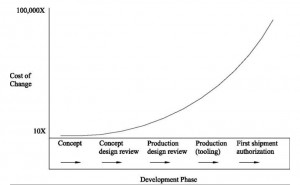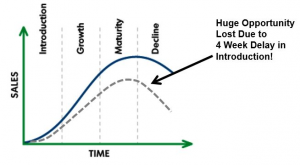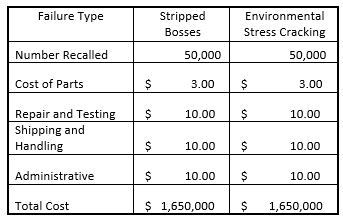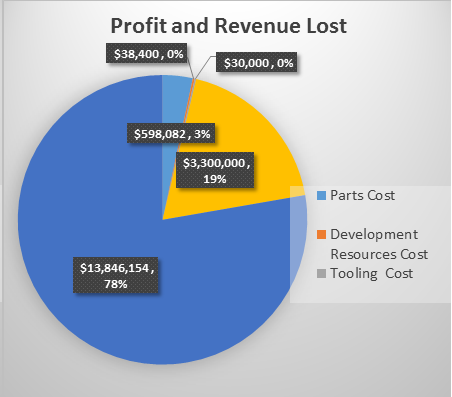 In my view, a product designer is like the quarterback in American football. The quarterback is responsible for the outcome of each individual play and his successes and failures can have a significant impact on the fortunes of his team. Even the strongest offence and defense team cannot make up for the deficiency of a quarterback.
In my view, a product designer is like the quarterback in American football. The quarterback is responsible for the outcome of each individual play and his successes and failures can have a significant impact on the fortunes of his team. Even the strongest offence and defense team cannot make up for the deficiency of a quarterback.
Likewise, the design engineer plays a major role in performance of the product. The others in the team such as the material supplier, the tool maker and the manufacturer cannot make up for the deficiencies in the design. A vast majority of the apparent material, tooling, processing and abuse issues can also be linked back to design errors.
As designers, we take pride in creating robust products. Every design should be robust enough to meet or exceed the functional requirement over the projected life, intended environmental conditions and the physical appearance. However considering the competition and changing consumer preferences every designer should also ensure that the product is as cost effective as possible.
Let’s take a look at what makes up the total cost of a product and what costs can be avoided or eliminated.
Normal Costs
- Development costs (reasonable CAD, analysis, prototyping, verification costs)
- Tool, tool development and qualification costs
- Total part cost (if n is the total number of products produced, n* reasonable individual part cost)
Avoidable Costs
Avoidable costs are those that are attributed to the direct and indirect costs (scrap costs, wasted engineering resources cost, tooling costs, etc.) that occur due to design errors and engineering changes that could have been avoided. Figure 1 depicts the traditional cost of design change curve for the product lifecycle. As you can see, the cost of a design error and change increases exponentially, the later it occurs in the development lifecycle.

Companies pay even a bigger price if errors are detected after the product is delivered to customers. It not only leads to expensive recalls but can completely damage a company’s reputation.
Leading Automotive OEM had to recall vehicles due to the faulty ignition switch which led to huge losses for the company. The cost for getting the switch designed right in the first place would have been minimal but the total cost of the vehicle recall was in billions.
Opportunity Costs
The figure below represents a commonly acceptable life span of a product.

The solid line shows the total anticipated sales for a product over its intended life. The dotted line represents what may happen to sales if the product release is delayed by 4 weeks. The difference between the integrals of the two curves potentially represents the total revenue loss or the total opportunity costs
Leading aircraft manufacturer, Boeing had to temporarily halt the deliveries of Boeing 787 because of the battery overheating issues. This costed the aircraft manufacturer approx. $600 million [1] in direct costs. As large as this figure is, it may still dwarf compared to the loss in opportunity costs. Losing the sales of even 5-6 aircrafts to the competition may mean revenue losses of over a billion dollars.
To explain the impact of simple design errors on overall product costs I will take the example of a hand held computing device
Case Example:
In this hypothetical but realistic example, the assembly of a hand held computing device consisted of a plastic cover, a sheet metal chassis to support the LCD display and four custom machined studs that fastened the PC board to the cover and metal chassis. The average selling price of the product was $300. The marketing department estimated total sales of one million units over three years. Design errors in the product were leading to engineering changes and rework, impacting product cost and time to market. On evaluating the situation it was identified that the errors were occurring primarily because designers were not aware of the proper design and manufacturability rules and because of the timeline pressures, the design was released to tooling without the needed validation.
Design Errors and the Impact on Product Costs
Increased Part Costs
- Inadequate draft caused the part to be distorted during ejection. In order to reduce the distortion, the cycle time was increased from 30 seconds to 45 seconds for the part to cool down enough to prevent the distortion. Because the part still had occasional difficulties in ejection, the yield rate went from 99% to 95%. Over the life of the product, this small design error resulted in a total increased part cost of USD 213,000.

- Another error detected was the hole diameter. One of the holes in the stamping was less in diameter than the metal thickness which led to occasional punch breakage during the stamping process. The manufacturing team decided to drill the smaller diameter hole in a secondary operation resulting in an additional cost of USD 0.15/part and a loss in yield from 99% to 95%. The overall cost impact to the organization was USD 161,447.

- The lack of the flute angle at the bottom of the hole resulted in an extra counter boring operation on the Swiss screw machine resulting in an increase of USD 0.01. There were four of these parts per assembly. The total increase in cost was USD 10,000.

Increased Resource Costs
The table below breaks down the normal and avoidable development costs. The avoidable costs were relatively low due to the fact that there were no parts in the inventory that had to be scrapped. If parts had to be scrapped, the avoidable costs would have been significantly higher. The total cost of the additional resources was $19,200. More importantly, these resources were not available for new product development as they were engaged in non-value added rework and engineering changes.

Increased Tooling Costs
Each engineering change to the tool cost an average of USD 5,000

Increased Warranty Costs
Because of the inadequate number of threads being engaged at the four corner bosses, they were stripping even on small drops. Additionally, because of the sharp corners along the edges of the covers, along with a sudden wall thickness reduction of 50 percent, the covers were under very high stress areas and were cracking in the operators’ hands. For more details on environmental stress cracking and stress concentration in sharp corners, read my previous blog post Click Here
The table below shows the cumulative warranty and repair costs totaling USD 1,650,000

Opportunity Costs
The engineering changes and the work-arounds after the tools were completed delayed the introduction of the product by four weeks. The following table illustrates the loss in market share due to the delay. (For the purpose of simplicity, let us assume that the overall effect of the lowering and compression of sales curve equated to four weeks of revenue losses during its peak in the second year).
Total loss – USD 13,846,154.
The table and the chart below sum up the significant lost profits and revenue for seemingly very insignificant design deficiencies.


The total combined loss was $ 17,812,636 or almost six percent of the initially forecast revenue!
Conclusion
It is evident that the seemingly small design and manufacturability errors can be have dramatic impact on product performance and costs. DFMPro safeguards against these errors which can be easily missed during the design stage.
